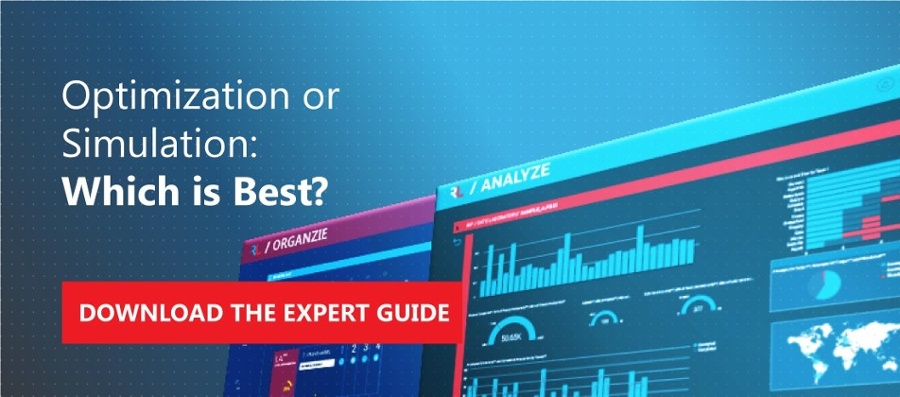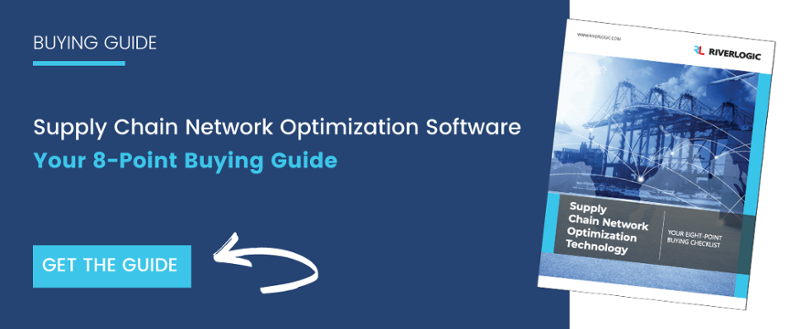As companies grow, their supply chains become complex and difficult to manage. A point is reached where it becomes increasingly difficult to make the right supply chain decisions due to inflexibility of the supply chain model — a point where the model no longer reflects the current realities of the market or the supply chain, itself.. It’s at this point that many supply chain managers are turning to another form of supply chain model. This type uses mathematical optimization modeling software to determine appropriate supply chain decisions.
In this blog, we’ll cover:
- The definition of supply chain modeling
- Why it’s important
- Common theories
- Putting theory into practice
- The Need for Informed, Forward-looking Decisions
- Benefits of dynamic modeling
What Is Supply Chain Modeling?
Supply chain modeling represents a conscious attempt to bring order into a supply chain to achieve certain business objectives, such as lowest supply cost, on-time delivery and an ability to cope with disruption. It deals with questions such as:
- What to produce
- Market identification
- Siting of production plants
- Finding the best suppliers
- Supplier and plant locations
- Transportation and inventory
- Distributing finished products
- Warehousing strategies
Supply chain theory is well-established. However, when setting up a supply chain model, there’s an almost endless list of requirements to meet, and as the number of SKUs, plants, and customers grows, the model’s complexity increases exponentially. What may have started as a relatively simple exercise of optimizing supply and distribution costs for one or two products quickly turns into a nightmarish exercise where it’s almost impossible to engineer the optimal solutions.
Why Is Supply Chain Modeling So Important?
The ultimate goal of any supply chain must be to satisfy the final customer. Satisfied customers return to buy more products, and through this process, successful organizations develop brand loyalty and recognition. According to customer service consultant Micah Solomon, customer satisfaction starts with:
- A perfect product
- On time delivery
- Friendly service
- Effective problem resolution
To achieve this, you need the right supply chain model, but not only that, you need to manage it effectively. This demands two things. Firstly, your model must be robust and fit for purpose. Secondly, your model should have internal visibility so you can identify problems and deal with them proactively. You need to be able to interrogate the model to discover the best solution for every key decision.
Supply chain modeling provides forward-looking companies with the tools they need to manage their supply lines to:
- Control inventory
- Reduce costs
- Meet customer demand
- Increase efficiency
- Respond to demand
It is due to supply chain excellence that Unilever was recognized by Gartner as one of the five companies in its Masters Category. This category recognizes businesses that have consistently scored in the top five supply chain rankings for seven out of the past ten years. However, this doesn’t come easily. Top supply chain companies recognize that, as their business changes, their technology investments, supply chain strategies, and decision-making models must also change. Thus, investment in advanced analytics is top of mind for these companies.

Customary Theory of Supply Chain Modeling
Supply chains tend to fall into one of two broad categories: those that focus on efficiency and those that are responsive. These are broken down further into six categories:
- Continuous-flow models for mature and stable industries
- Fast chain models producing fashion and trendy products with a short lifecycle
- Efficient supply chain models delivering highly competitive products based on price
- Custom-configured models for products with multiple configurations
- Agile supply chain models for made-to-order products with unpredictable demand
- Flexible models to handle seasonal demand peaks
Each model has certain requirements, and the primary role of the supply chain manager is to design a supply chain model that best meets the above requirements. Naturally, there’s often a degree of overlap that must be allowed for and incorporated into the model.
Customary modeling focuses on setting up a supply chain that meets specific requirements and, as the organization matures, adapting the supply chain to meet changing circumstances.
Transferring Supply Chain Modeling Theory into Practice
The difficulties supply chain managers face is that supply chain management is a dynamic exercise unsuited to static modeling. What appears great on paper rarely functions as anticipated. While delivery and quality problems are obvious and generally receive urgent attention, soft issues such as cost optimization and risk analysis are harder to deal with, in part, because information isn’t readily available. Also, supply chain complexity, lack of visibility into the supply chain and the need to improve revenue represent major challenges. Another issue facing organizations is a lack of adequate strategic planning tools, which means that as many as 79 percent use spreadsheets for supply chain planning. What is interesting is that only 47 percent believe their supply chain plans are accurate.
The supply chain models referred to earlier are an essential component of supply chain planning for setting up supply chains. Thereafter, they play a small role in managing the supply chain and resolving supply issues other than to point toward best practice. Similarly, spreadsheet planning that relies on a snapshot is quickly out of date, and such planning rarely takes into account the full picture. What’s needed is a dynamic supply chain modeling solution.
The Need for Informed, Forward-looking Decisions
When confronted with the need to make informed supply chain decisions, managers’ access to high-quality historical data as well as forward-looking information, such as sales trends, forecasts and an idea of what may happen in the future, is essential. Although much data is available from business intelligence software, what’s missing is the intelligence to guide the right decisions. For example, conventional supply chain modeling tools can’t tell leaders exactly what will happen to the bottom line if you increase production at a particular facility to meet anticipated demand. In fact, answering that question with conventional business intelligence tools entails a lot of guesswork.
However, if you build a mathematical model that accurately reflects how your business functions, you can interrogate this model to see the effect of increasing production. While this may seem an almost impossible task, the reality is that it’s entirely feasible, especially when using modeling tools that obviate the need for generating computer code through the use of intuitive drag-and-drop interfaces. As many organizations have discovered, this is possible; once the model is validated using known events, it’s possible to measure the effects of change. Additionally, through the use of optimization solver software, it’s possible to take your decision-making to the next level to answer questions such as which supply chain combination maximizes profitability or how to reduce logistic costs while meeting demand.
Benefits of Dynamic Supply Chain Modeling
The benefits of creating a model of your business, populated by your own data, are many. Possibly the most important is the ability to discover the interaction between different parts of the organization and how they can be harnessed to improve overall profitability. Because the model works with your data, and also because of the ability to calibrate the model so it reflects reality, you can have confidence in its integrity. Additionally, with the ability to factor in constraints and to pose multiple what-if scenarios, it’s possible to anticipate and mitigate the effects of uncontrollable events and to determine the most profitable operational strategies.
What’s also important is that when you use this type of drag-and-drop modeling, it’s easier to internalize the model so your own people can work with it and develop it further without the need to rely on high-level coding experts.




